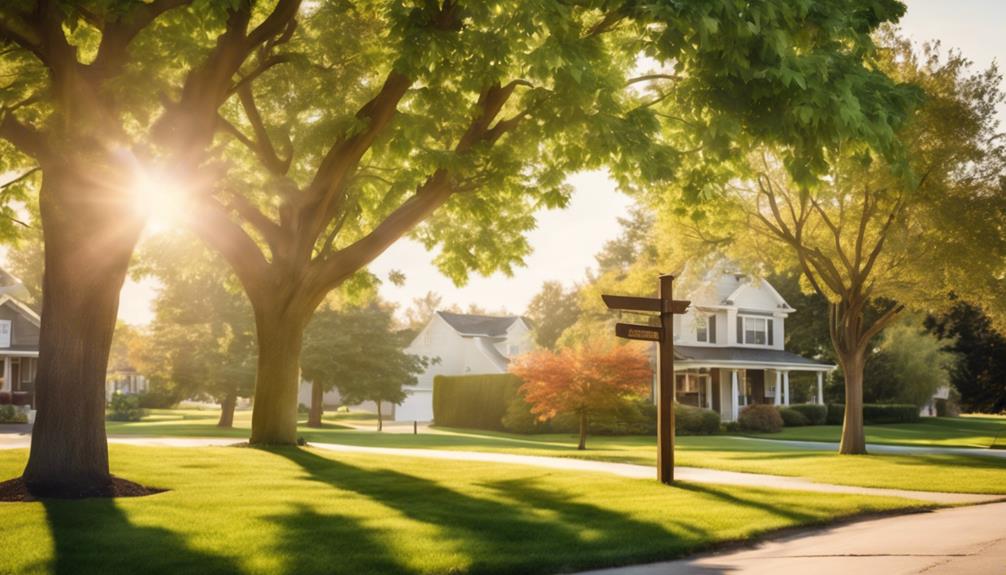
Smart Fencing Installation Tips for Small Gardens
14 January 2025
Decking Northfield
14 January 2025The three best mulching services for improved tree health include 1) organic mulch application, which enhances moisture retention and nutrient availability, 2) specialised mulching techniques that ensure proper layer thickness and placement, and 3) ongoing maintenance services that replenish mulch and manage decomposition.
These services not only promote healthy root development but also assist in controlling pests and reducing weed competition.
Opting for professional mulching can significantly enhance the health of your trees.
There are many effective strategies available, and exploring these further can provide valuable insights into maintaining optimal tree health.
Mulching Benefits for Tree Vitality
Mulching plays an essential role in enhancing tree vitality by promoting moisture retention and regulating soil temperature.
By creating a protective layer, mulch minimises evaporation, ensuring that trees have consistent access to water.
Furthermore, it helps maintain a stable soil temperature, which is important for healthy root development and overall tree growth.
Moisture Retention Enhancement
Enhancing moisture retention in the soil is a crucial factor for promoting tree health, especially during periods of drought or fluctuating weather conditions. Effective mulching acts as a barrier that reduces evaporation, thereby maintaining a consistent moisture level around the tree's root zone.
Organic mulch materials, such as wood chips or bark, decompose over time, enriching the soil with nutrients whilst simultaneously improving its structure. This improved soil structure facilitates better water infiltration and retention, ensuring that trees have access to the moisture they require for optimal growth.
Furthermore, well-maintained mulch layers can mitigate competition from weeds, which often absorb moisture and nutrients, further fostering a robust environment for tree health. Consequently, strategic mulching is indispensable for sustaining tree vitality.
Soil Temperature Regulation
Maintaining ideal soil temperatures is essential for the overall health and vigour of trees, as fluctuations can stress root systems and hinder growth. Mulching serves as an effective thermal barrier, moderating soil temperatures by insulating the root zone. In hot climates, mulch can mitigate excessive heat, preventing root damage and promoting nutrient uptake.
Conversely, in cooler months, it retains warmth, fostering a suitable environment for microbial activity and root development.
Moreover, the decomposition of organic mulch contributes to improved soil structure, further enhancing temperature regulation. By applying mulch at an appropriate depth—typically 5 to 10 centimetres—tree vitality is considerably bolstered.
Therefore, integrating mulching practices not only supports temperature stability but also advances the overall health and resilience of trees in diverse environments.
Soil Moisture Retention Techniques
Effective soil moisture retention is critical for maintaining tree health, and several factors contribute to this process.
The quality of organic material used in mulching, the recommended thickness of the mulch layer, and the composition of the mulch material all play significant roles in optimising moisture retention.
Understanding these elements can enhance the effectiveness of mulching practices in supporting tree health.
Organic Material Quality
Utilising high-quality organic materials is essential for improving soil moisture retention in mulching practices. The selection of organic mulch influences not only moisture retention but also the overall health of the ecosystem surrounding trees.
Here are key factors to consider:
- Compost Quality: Ensure the compost is well-aged to avoid nitrogen depletion in the soil.
- Wood Chips: Opt for hardwood chips, as they decompose slowly and provide long-term moisture benefits.
- Straw or Hay: Use these materials to create a protective layer that reduces evaporation.
- Bark Mulch: Select finely shredded bark, which enhances moisture retention while allowing air circulation.
Mulch Thickness Recommendations
While the type of organic material used in mulching plays a crucial role in enhancing soil moisture retention, the thickness of the mulch layer is equally significant.
An appropriately applied mulch layer can maximise moisture conservation and promote healthy root systems.
Here are recommended mulch thicknesses for effective moisture retention:
- 5 to 7.5 cm – Ideal for flower beds and vegetable gardens, allowing water to penetrate effectively.
- 7.5 to 10 cm – Suitable for trees and shrubs, offering sufficient insulation against temperature extremes.
- 10 to 15 cm – Beneficial for newly planted trees, aiding in moisture retention during establishment.
- Avoid excessive thickness – Greater than 15 cm can suffocate roots and hinder moisture absorption.
These guidelines ensure the best moisture management for thriving plant health.
Mulch Material Composition Importance
The composition of mulch materials plays a pivotal role in their ability to retain soil moisture and support overall plant health. Selecting the right mulch not only enhances moisture retention but also encourages beneficial microbial activity and mitigates soil temperature fluctuations.
Understanding the key components of effective mulch can lead to superior outcomes for your landscaping.
Consider the following factors in mulch material composition:
- Organic Matter: Composts or wood chips that decompose enrich the soil.
- Particle Size: Finer materials retain moisture more effectively but may compact.
- Cation Exchange Capacity: Certain mulches enhance nutrient availability.
- Colour and Texture: Darker mulches absorb heat, aiding in moisture retention.
Mulch Layer Application Techniques
Effective application of mulch layers is crucial for promoting tree health and optimising soil conditions.
Choosing the right type of mulch, ensuring proper placement techniques, and considering the layering of different mulch types can significantly improve moisture retention and nutrient availability.
This discussion will investigate these critical aspects to achieve the best results in mulching practices.
Choose the Right Mulch
Selecting the appropriate mulch is essential for enhancing tree health and improving soil conditions. The right mulch not only suppresses weeds but also retains moisture and enhances soil structure.
When choosing mulch, consider the following factors:
- Material Type: Organic options like wood chips, bark, or straw enrich the soil as they decompose, while inorganic materials such as gravel provide longevity without contributing nutrients.
- Texture: Coarse mulch promotes better airflow and drainage, whereas fine mulch retains moisture more effectively.
- Colour: Darker mulches absorb heat, potentially benefiting plant growth, while lighter colours reflect sunlight, keeping the soil cooler.
- Depth: The ideal mulch layer varies based on material, typically ranging from 5 to 10 centimetres, ensuring maximum moisture retention without suffocating tree roots.
Proper Mulch Placement Techniques
When applying mulch, proper placement is crucial to maximising its benefits for tree health and soil quality. Incorrect application can lead to moisture retention issues, root suffocation, and fungal diseases.
To guarantee ideal results, adhere to the following techniques:
- Distance from the Trunk: Maintain a gap of 3-6 inches from the tree trunk to prevent moisture accumulation and decay.
- Thickness of Layer: Apply a mulch layer of 2-4 inches to retain moisture and effectively suppress weeds.
- Even Distribution: Spread mulch evenly around the tree, extending to the drip line, to ensure consistent moisture absorption.
- Avoid Compaction: Avoid packing the mulch too tightly; loose placement facilitates air circulation and root development.
Layering Different Mulch Types
The art of layering different types of mulch can significantly enhance the health of trees and improve the quality of the surrounding soil. This technique boosts moisture retention, suppresses weeds, and promotes nutrient cycling.
To achieve optimal results, consider the following steps:
- Base Layer: Begin with coarse mulch, such as wood chips or bark, to provide excellent drainage and aeration.
- Intermediate Layer: Introduce a medium layer of organic mulch, such as shredded leaves or straw, to enhance soil fertility as it decomposes.
- Top Layer: Conclude with a fine mulch, such as compost or pine needles, to retain moisture and offer an aesthetically pleasing appearance.
- Regular Maintenance: Routinely replenish the layers to ensure continued effectiveness and the health of both the tree and soil.
This strategic layering fosters a thriving ecosystem for tree growth.
Enhanced Soil Nutrient Availability
Improving soil nutrient availability is a significant benefit of mulching that greatly contributes to tree health. Organic mulches decompose over time, releasing essential nutrients such as nitrogen, phosphorus, and potassium into the soil. These elements are crucial for the optimal growth and development of trees.
| Nutrient | Source of Nutrient | Benefit to Trees |
|---|---|---|
| Nitrogen | Decomposed organic matter | Promotes leaf and stem growth |
| Phosphorus | Bone meal or compost | Increases root development |
| Potassium | Wood chips and bark | Enhances drought resistance |
| Calcium | Lime or crushed eggshells | Strengthens cell walls |
| Magnesium | Epsom salts | Aids in photosynthesis |
Mulch for Pest Control
Mulch plays an essential role in pest control by creating a favourable environment for beneficial organisms while deterring harmful pests.
Organic mulch not only improves soil health but also helps retain moisture, which is important for plant resilience against pest infestations.
Implementing proper watering techniques further optimises the effectiveness of mulch in maintaining a healthy ecosystem around trees.
Organic Mulch for Soil Health
Using organic mulch can considerably benefit soil health while providing an effective means of pest control.
Organic mulch, such as wood chips, straw, or grass clippings, improves the soil's biological activity, leading to better nutrient availability and moisture retention. Furthermore, it creates a habitat for beneficial organisms that can help deter pests.
Here are four key advantages of organic mulch for soil health:
- Nutrient Enrichment: As it decomposes, organic mulch releases essential nutrients into the soil.
- Soil Structure: It enhances soil aeration and structure, promoting root development.
- Moisture Regulation: Organic mulch helps retain soil moisture, reducing the need for frequent watering.
- Weed Suppression: A thick layer of mulch prevents weed growth, minimising competition for nutrients.
Wood Chips for Moisture Retention
Wood chips serve as an excellent choice for moisture retention in landscaping and garden settings. Their ability to hold moisture not only improves the health of plants but also minimises the frequency of watering.
Utilising wood chips effectively promotes a sustainable environment, offering a multitude of benefits:
- Soil Insulation: Wood chips regulate soil temperature, protecting roots from extreme heat or cold.
- Organic Matter: As they decompose, they enrich the soil with nutrients, fostering healthier plant growth.
- Erosion Control: Wood chips reduce soil erosion by stabilising the surface during heavy rains.
- Weed Suppression: A thick layer of wood chips inhibits weed growth, allowing plants to thrive without competition.
Incorporating wood chips into your landscaping strategy can greatly improve moisture retention and overall plant health.
Proper Mulch Watering Techniques
Effective moisture retention through wood chips not only supports plant health but can also play a significant role in pest control.
Proper watering techniques are crucial to optimise the benefits of mulch while minimising pest attraction. Here are four key practices to take into account:
- Water Deeply and Infrequently: Aim for thorough watering sessions that penetrate deep into the mulch layer, encouraging root depth.
- Monitor Moisture Levels: Use a moisture meter to verify that the mulch remains adequately moist without becoming waterlogged.
- Avoid Over-Watering: Excess moisture can lead to fungal growth, attracting pests; allow the top layer to dry slightly between waterings.
- Apply Mulch After Watering: Ensure the soil is adequately moistened before applying mulch, promoting immediate absorption and pest deterrence.
Implementing these techniques will improve both tree health and pest management.
Mulch Decomposition Issues
Mulch decomposition can significantly impact tree health by influencing root compaction and aeration.
Addressing these issues necessitates effective strategies to alleviate root compaction and enhance overall root health.
Root Compaction Mitigation Strategies
As tree health is profoundly influenced by soil conditions, addressing root compaction is vital for promoting vigorous growth and vitality.
Compacted soil restricts root development and hinders water and nutrient absorption, negatively impacting the overall significance of trees.
Here are four effective strategies for mitigating root compaction:
- Aeration: Employ mechanical aerators to create holes in the soil, facilitating improved air and water penetration.
- Organic Mulching: Apply organic mulch to enhance soil structure and moisture retention, thus alleviating compaction.
- Soil Amendments: Incorporate compost or other organic matter to improve soil texture and boost microbial activity.
- Proper Irrigation: Implement a targeted irrigation system to prevent over-saturation, which can exacerbate compaction issues.
Root Health Improvement Strategies
How can mulch decomposition impact root health? The decomposition process of mulch is critical to the sustenance of tree roots, as it influences soil nutrient availability and moisture retention.
When mulch decomposes improperly, it can lead to several issues that adversely affect root health. To mitigate these effects, consider the following strategies:
- Select Appropriate Mulch: Use organic materials such as wood chips or bark to ensure a slow decomposition rate, promoting nutrient release over time.
- Maintain Adequate Depth: Apply mulch to a depth of 5-10 cm to optimise moisture retention while preventing anaerobic conditions.
- Monitor Moisture Levels: Ensure the mulch remains damp but not waterlogged, as excess moisture can lead to root rot.
- Avoid Mulch Volcanoes: Keep mulch away from the root collar to prevent suffocation and disease.
Implementing these strategies will foster a healthier environment for tree roots.
Root Aeration Techniques
Effective root aeration techniques play a crucial role in mitigating the adverse effects of mulch decomposition on tree health.
As mulch breaks down, it can create a dense layer that restricts air and water movement to the roots. Employing proper aeration methods guarantees that trees receive the necessary oxygen and nutrients.
Consider the following techniques:
- Core Aeration: Use a machine to remove soil cores, promoting airflow to the roots.
- Spike Aeration: Utilise a spiked tool to perforate the soil, improving aeration.
- Vertical Mulching: Create vertical holes filled with compost to enhance air and water infiltration.
- Soil Amendments: Incorporate organic matter to improve soil structure and aeration.
Implementing these strategies will greatly boost tree health and resilience.
Why Choose TKL Birmingham Gardener
When it comes to enhancing the health and aesthetics of your garden, selecting the right service provider is essential, and TKL Birmingham Gardener stands out as a premier choice.
With a commitment to excellence, TKL Birmingham Gardener employs skilled professionals who are knowledgeable in advanced mulching techniques that promote optimal tree health. Their thorough approach ensures that each mulch application is tailored to the specific needs of your garden, enhancing moisture retention and regulating soil temperature.
Furthermore, TKL Birmingham Gardener utilises high-quality, organic materials, fostering a sustainable ecosystem that supports beneficial microorganisms.
Their customer-centric philosophy guarantees meticulous attention to detail and responsive service, making them not just a service provider but a trusted partner in your gardening endeavours.
Choosing TKL Birmingham Gardener means investing in the longevity and vibrancy of your landscape.
Common Mulching Questions Answered
Understanding the nuances of mulching can greatly enhance the benefits it provides to your garden, particularly when carried out by experts like TKL Birmingham Gardener.
A common question concerns the ideal thickness for mulch; typically, a 5 to 10-centimetre layer is recommended to suppress weeds while allowing moisture penetration.
Another frequent inquiry pertains to the best materials; organic options such as wood chips and straw enrich the soil as they decompose, while inorganic materials like rubber provide longer-lasting coverage.
Many wonder about the timing of application; ideally, mulch should be applied in spring or autumn to maximise its benefits.
Final Mulching Recommendations
The success of your garden's health largely hinges on the final mulching recommendations you choose to implement.
To enhance your mulching strategy and promote tree health, consider the following expert suggestions:
- Select Organic Materials: Utilise compost, bark, or wood chips to improve soil structure and nutrient content.
- Maintain Ideal Depth: Apply mulch to a depth of 5-10 centimetres, ensuring it is neither too thick to suffocate roots nor too thin to provide adequate coverage.
- Keep Mulch Away from Trunks: Avoid contact with tree trunks to prevent rot and pest infestation; maintain a gap of 5-8 centimetres.
- Replenish Regularly: Monitor mulch levels and replenish as needed to maintain effectiveness, typically once or twice a year.
Implementing these recommendations will enhance your trees' resilience and overall well-being.




